
AirAsia Group Berhad (“AirAsia” or “the Group”) is pleased to announce the operating statistics for the First Quarter of the Financial Year 2020 (“1Q2020”).
Despite the weak travel demand amid increasing and unprecedented travel restrictions due to the COVID-19 pandemic, AirAsia reported a healthy group-wide load factor of 80%, which was better than its expected 77%. This was achieved through proactive capacity management, particularly in the months of February and March, with the cuts most notable in AirAsia Malaysia and AirAsia Thailand.
The Group Consolidated AOCs¹ reported a steady load factor of 78%. The number of passengers carried was down 21% year-on-year (“YoY”) to 9.9 million as capacity was reduced by 11%.
In 1Q2020, AirAsia Malaysia reduced its capacity by 17% YoY, as business was heavily interrupted in light of the increase in COVID-19 cases in many markets and the imposed Movement Control Order in Malaysia that began on 18 March 2020. AirAsia Malaysia carried 27% less passengers YoY, with a reasonably strong load factor of 77%.
AirAsia Indonesia posted a 10% YoY increase in capacity for the quarter even though its available seat kilometres (“ASK”) retracted by 4%, as the company re-deployed excess capacity from international to domestic sectors. Passengers carried decreased by 7% as travel demand in the region started to weaken, while load factor was moderate at 74%. During the quarter, AirAsia Indonesia began flying Jakarta-Medan.
AirAsia Philippines flew 1.8 million passengers during the quarter, down 9% in comparison to the same quarter last year. Capacity reduced by 1% YoY as domestic routes and international routes were halted beginning mid-March 2020. Load factor was solid at 84%.
Capacity realignment and route rationalisation embarked upon by AirAsia Thailand in 2019 continued during the quarter to match the low travel demand. Capacity was reduced by 17% while ASK declined by 30%, as AirAsia Thailand’s network was realigned through frequency reduction and flight suspension on international routes due to increasing travel restrictions and redeployment of excess capacity to domestic sectors. AirAsia Thailand recorded 84% in load factor as it carried 4.5 million passengers, 23% lower than 1Q2019.
AirAsia India reported a 30% growth in passengers carried to 2.5 million with the 43% additional capacity contributed by 10 more aircraft YoY. The AOC closed the quarter with a sizable fleet of 30 aircraft. Load factor remained steady at 81% despite rising travel concerns.
AirAsia Japan’s capacity expanded by 48% while ASK increased by 30% YoY with the addition of its latest route, Nagoya-Sendai which was launched in 3Q2019. Load factor was soft at 72% for the quarter as passengers carried increased at a slower rate of 32% YoY.
At the end of 1Q2020, AirAsia had announced a temporary fleet hibernation across its AOCs in view of the COVID-19 pandemic causing large-scale border restrictions in many countries. The effort to assist in containing the spread of COVID-19 is in line with the movement and travel restrictions imposed by governments of the markets that the Group fly to. While the safety and well-being of passengers and employees remain the highest priority, AirAsia continues to proactively assess the situation and is prepared to gradually resume its flights as soon as possible.
AirAsia Group targets to end 2020 with 244 aircraft, a net reduction of 1 aircraft from 245 aircraft as at end 2019.
AirAsia Group Berhad Consolidated AOCs – Malaysia, Indonesia & Philippines1st Quarter 2020 Operating Statistics

Note: (i) The fleet count excludes:
- Two (2) A320 aircraft leased to a third party airline
- Two (2) A320 aircraft leased to a third party airline
Malaysia 1st Quarter 2020 Operating Statistics

Note: (ii) The fleet count excludes:
- Two (2) A320 aircraft leased to a third party airline
- Two (2) A320 aircraft leased to a third party airline
Indonesia1st Quarter 2020 Operating Statistics
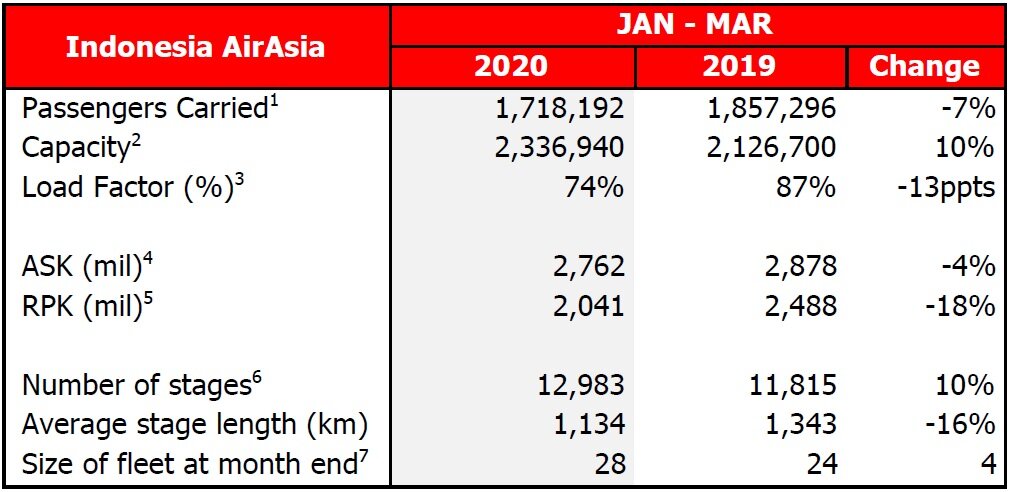
Philippines1st Quarter 2020 Operating Statistics
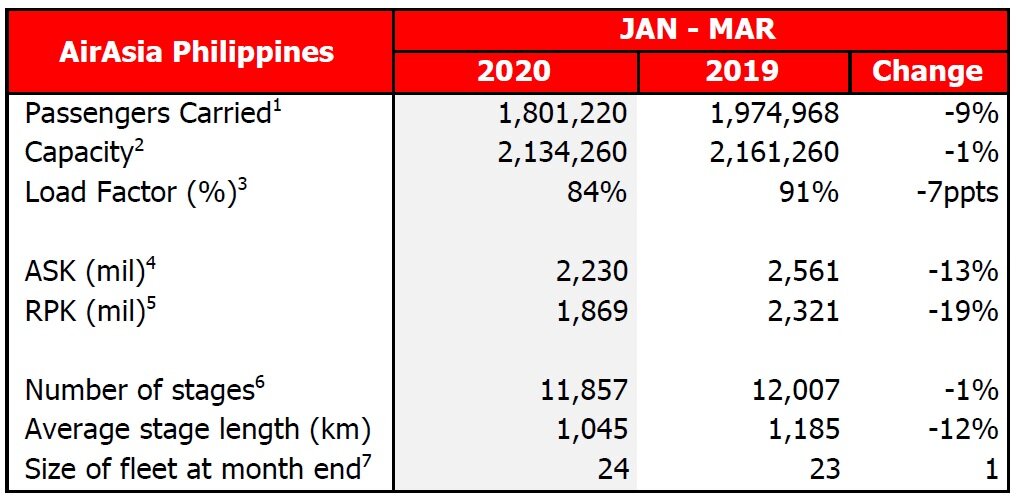
Thailand1st Quarter 2020 Operating Statistics
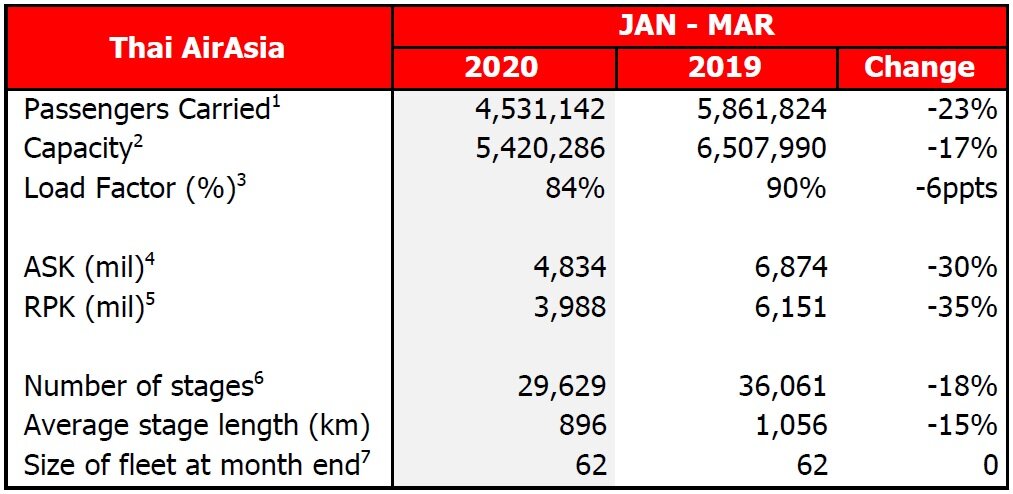
India1st Quarter 2020 Operating Statistics
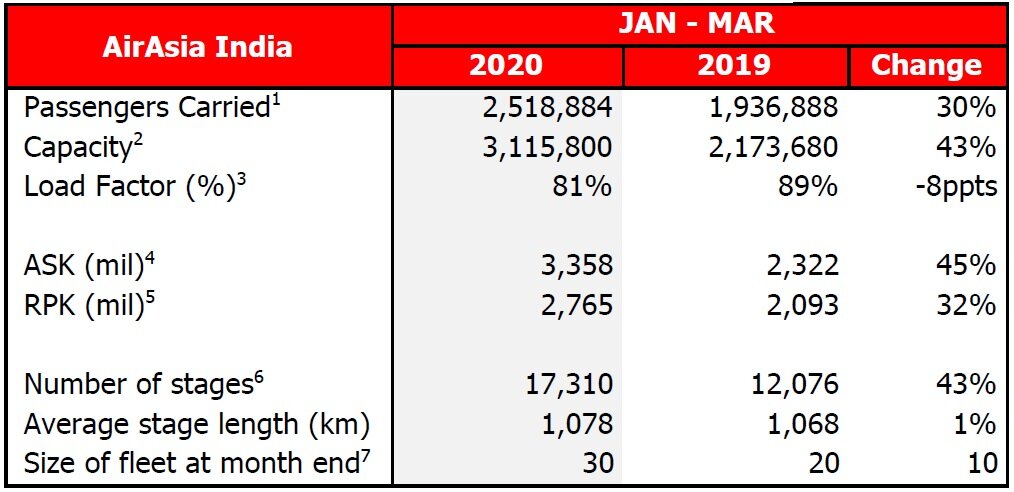
Japan1st Quarter 2020 Operating Statistics
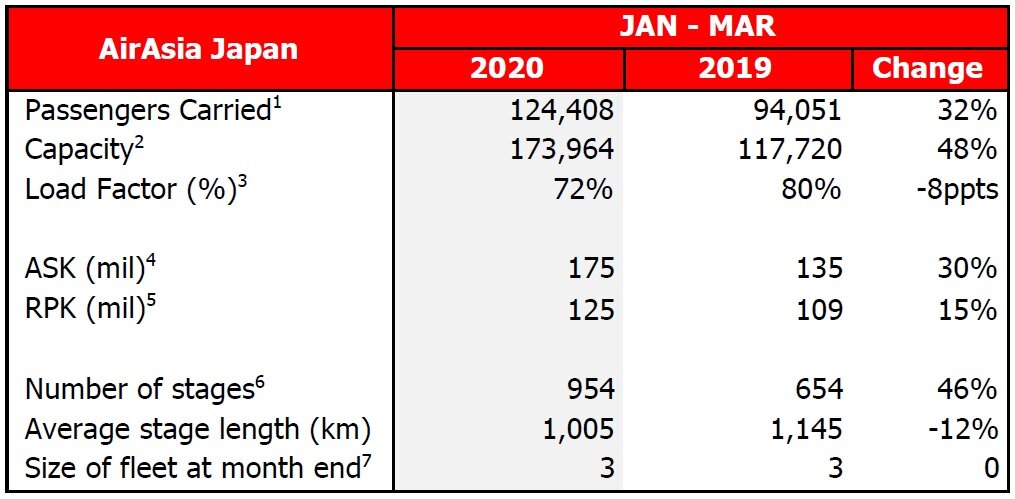
(1) Number of earned seats flown. Earned seats comprise seats sold to passengers (including no-shows)
(2) Number of seats flown
(3) Number of Passengers carried as a percentage of Capacity
(4) Available Seat Kilometres (ASK) measures an airline’s passenger capacity. Total seats flown multiplied by the number of kilometres flown
(5) Revenue Passenger Kilometres (RPK) is a measure of the volume of passengers carried by the airline. Number of passengers multiplied by the number of kilometres these passengers have flown
(6) Number of flights flown
(7) Number of aircraft including spares
(2) Number of seats flown
(3) Number of Passengers carried as a percentage of Capacity
(4) Available Seat Kilometres (ASK) measures an airline’s passenger capacity. Total seats flown multiplied by the number of kilometres flown
(5) Revenue Passenger Kilometres (RPK) is a measure of the volume of passengers carried by the airline. Number of passengers multiplied by the number of kilometres these passengers have flown
(6) Number of flights flown
(7) Number of aircraft including spares
¹ AirAsia Group Berhad Consolidated AOCs refers to AOCs whose financial and operational results are consolidated for financial reporting purposes and these are namely the Malaysian, Indonesian and Philippine AOCs.
Tags: AirAsia Group Berhad